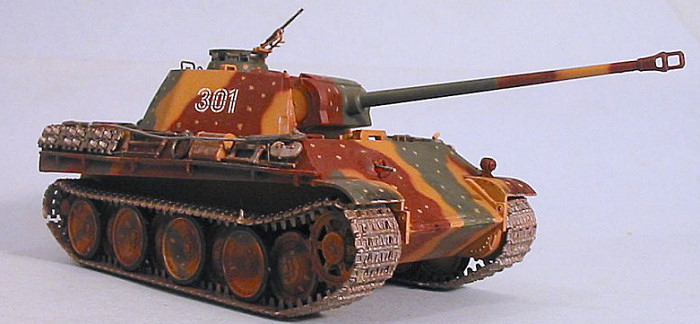
| KIT: | Tamiya 1/48 Panzer V Panther ausf G |
| KIT #: | 32520 |
| PRICE: | ¥1800 at www.hlj.com |
| DECALS: | Three options |
| REVIEWER: | Tom Cleaver |
| NOTES: |

| HISTORY |
After the war, German tank expert Hasso von Manteuffel told Basil Liddell-Hart that, "Tanks must be fast. That, I would say, is the most important lesson of the war in regard to tank design. The Panther was on the right lines, as a prototype... fire-power, armor protection, speed and cross-country performance are the essentials, and the best type of tank is that which combines these conflicting requirements with the most success. In my opinion the German Panzer V, the Panther, was the most satisfactory of all, and would have been close to the ideal had it been possible to design with a lower silhouette."
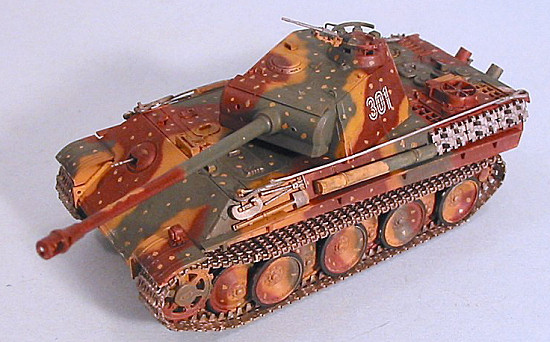 The Pzkw V, which came to
be known as the “Panther,” was a direct response to the Soviet T-34, which had
proven a nasty surprise to the heretofore-dominant German Panzers, with its
manifest superiority to the Pzkw IV models in service at the time Operation
Barbarossa began.
The Pzkw V, which came to
be known as the “Panther,” was a direct response to the Soviet T-34, which had
proven a nasty surprise to the heretofore-dominant German Panzers, with its
manifest superiority to the Pzkw IV models in service at the time Operation
Barbarossa began.
Recognizing the superiority of the T-34, General Heinz Guderian insisted a team be dispatched to the Eastern Front to assess the Soviet tank. Among the features which were considered most significant were the sloping armor - which gave much improved shot deflection and also increased the apparent armor thickness against penetration - and the wide tread track and large road wheels which improved mobility over soft ground.
Daimler-Benz and Maschinenfabrik Augsburg-Nürnberg AG (MAN) were assigned to design a new 30-35 ton tank, designated VK3002, by April 1942 - in time to be shown to Hitler for his birthday.
The two proposed were delivered in April 1942. The Daimler-Benz design was close
to a direct lift of the T-34, dropping the usual German over-engineering and
complexity, resulting in a clean, simple design much like the T-34 in hull and
turret, engine, drive system, suspension and track layout. The MAN design was a
more conventional German concept, higher and wider with a substantial turret
placed toward the rear of the hull, powered by a gasoline engine with a torsion
bar suspension and the standard German internal 5-man crew layout. Despite
Hitler’s expressed preference for the Daimler-Benz design, the MAN design was
accepted in May 1942 and a prototype was produced by September 1942 which was
accepted for immediate high-priority production after testing at Kummersdorf.
The first Pzkw Vs delivered in December suffered from reliability problems as a
result of this haste. Demand for the tank was so high that production was soon
expanded include first Daimler-Benz and later in 1943 Maschinenfabrik
Niedersachsen-Hannover and 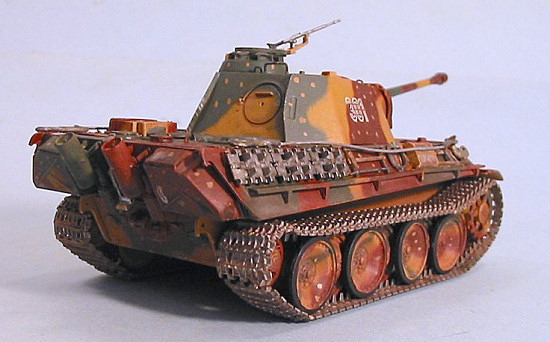 Henschel.
Henschel.
The Panther’s main weapon was the 75mm Rheinmetall KwK 42 L/70. While 75mm was not a particularly large caliber for the time, the Panther's cannon was one of the most powerful tank guns of the Second World War, because of the large propellant charge and long barrel, which gave a very high muzzle velocity. The weapon’s flat trajectory also made hitting targets much easier, since aiming was less sensitive to range. The Panther’s 75mm gun actually had more penetrating power than the 88mm gun of the Tiger I. The Panther could carry 79 rounds internally, and was also armed with two MG 34 machine guns - one fired by the assistant driver/radioman, and one mounted on the turret cupola for use by the commander.
The Panther first entered combat at the Battle of Kursk in July 1943, where it proved its value, though the engine and transmission were found to be vulnerable. Further development to the Ausf D as a result of what was learned at Kursk increased reliability and reduced the vulnerability of the power train. With the Ausf G, which entered production in February 1944, the Panther “came of age.”
In
the summer of 1944, the Panther proved to be a very nasty surprise to the Allies
during the Battle of Normandy, since it was a particularly dangerous opponent
for the Sherman tank that was used by the Allied armored units. Put simply, the
Sherman was no match for the Panther, which was also faster, more reliable, more
maneuverable and could go more places than the Tiger tank, which was essentially
a semi-mobile pillbox. The rule-of-thumb among Allied tank crews of
Sherman-to-Panther ratio necessary for destruction of a single Panther was 5:1,
the same as with the Tiger. The Panther’s sloped armor gave it nearly the immune
zone of the heavier Tiger.
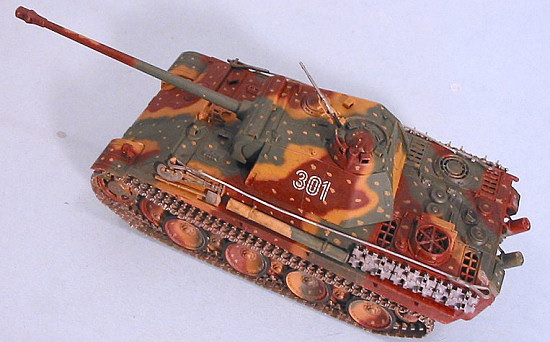 Demonstrating
the reliability of the Panther, one tank that entered combat in Normandy on June
15 survived the entire battle, destroying 30 Allied tanks over the course of
many encounters, and was driven out of northern France over one hundred miles
into Belgium by its crew in mid-August without any rear-unit support the entire
time.
Demonstrating
the reliability of the Panther, one tank that entered combat in Normandy on June
15 survived the entire battle, destroying 30 Allied tanks over the course of
many encounters, and was driven out of northern France over one hundred miles
into Belgium by its crew in mid-August without any rear-unit support the entire
time.
The Panther was not only popular with German crews. Captured Panthers were extremely popular with Soviet troops, who received them in reward for extraordinary achievements in combat. Contrary to official regulations that captured Tigers and Panthers should not be repaired but abandoned and destroyed after mechanical failure, Soviet crews sought to keep them in service as long as possible and the service manual was unofficially translated into Russian and given to the crews of captured Panthers.
Overall, the Panther was the best Axis tank in WWII, primarily because it overcame the Tiger's limitations by the introduction of sloped armor and the outstanding performance of its main gun.
| THE KIT |
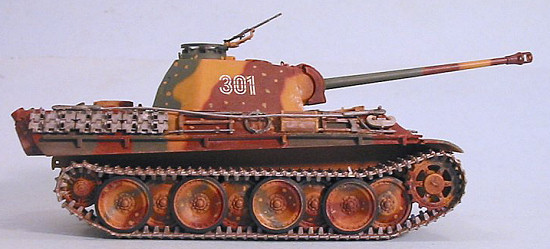 I well remember back at some
point in the mid-50s walking into the local hobby shop and there was a model of
a Real German Tank! It was the old Aurora 1/48 kit of the Panther, which I
believe was in fact the first kit made in the United States of a Real Enemy
Tank. That and the other Aurora1/48 kits may not have been up to today’s
standards, but I believe that was the last 1/48 model of a Panther tank before
this one by Tamiya.
I well remember back at some
point in the mid-50s walking into the local hobby shop and there was a model of
a Real German Tank! It was the old Aurora 1/48 kit of the Panther, which I
believe was in fact the first kit made in the United States of a Real Enemy
Tank. That and the other Aurora1/48 kits may not have been up to today’s
standards, but I believe that was the last 1/48 model of a Panther tank before
this one by Tamiya.
As Scott’s preview says, the kit does feel like the 1/35 kit scaled down. The small armor series has been getting more and more detailed with separate small pieces, and this kit is the most-detailed to date. As was noted before, the plastic parts are crisply molded, and there were no fit problems when I proceeded with assembly.
| CONSTRUCTION |
These kits do get easier to build as I do more of them. This time, I assembled the hull and turret completely before proceeding with the road wheels and tracks on the lower hull. I left off the tool racks and other items that sit on the hull, and proceeded with the assembly of the basic tank. When that was done, it was time for painting.
| COLORS & MARKINGS |
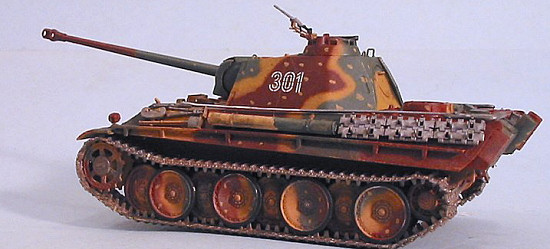 Painting:
Painting:
I decided to do the “ambush scheme” for a Panther of the 1st Panzer Division which was - I believe - involved in the Battle of the Bulge. Using Tamiya paints throughout, I started with Panzer Yellow, followed by Dark Green and finished off with Red-Brown. When that was done, I “dotted” the darker areas with small blotches of Panzer Yellow. I finished off by painting the rubber of the road wheels, and painted the tracks with Model Master Magnesium.
When all was dried, I gave the sub assemblies a wash of thinned Tamiya “Smoke,” followed by a light dry-brushing around sharp areas with Model Master Stainless Steel. I followed that with a wash of thinned Red-Brown over the road wheels and the tracks to simulate mud.
| FINAL CONSTRUCTION |
Assembly continues: It was now time to assemble the road wheels and attach the tracks. Everything fits well here, but it is a good idea to not glue the drive wheel into final position until you are sure you have the tracks correctly placed, because if you cannot move the drive wheel you cannot make the final adjustments to assure a tight fit of all the track parts.
With the lower hull completed, I attached the upper hull, and then proceeded to attach the tool racks, and other bits and pieces that are to either side of the hull.
| CONCLUSIONS |
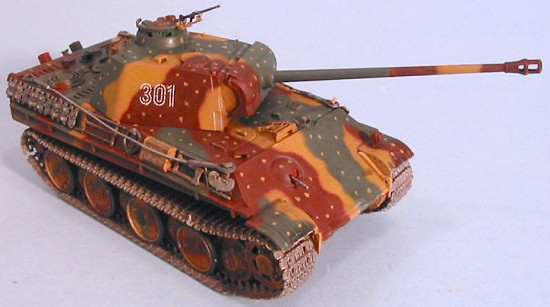 I have always thought the
Panther was one of the best-looking tanks to ever see service, going back to my
eager purchase of that old Aurora kit 50 years ago. This new kit by Tamiya is a
very worthy addition to their series of small armor models, and definitely the
most detailed release yet. If you’re not an armor modeler, but have been
thinking about it, these Tamiya kits are a good place to start.
I have always thought the
Panther was one of the best-looking tanks to ever see service, going back to my
eager purchase of that old Aurora kit 50 years ago. This new kit by Tamiya is a
very worthy addition to their series of small armor models, and definitely the
most detailed release yet. If you’re not an armor modeler, but have been
thinking about it, these Tamiya kits are a good place to start.
March 2006
Thanks to HobbyLink Japan - www.hlj.com - for the review kit.
If you would like your product reviewed fairly and quickly by a site that has over 300,000 visitors a month, please contact me or see other details in the Note to Contributors.